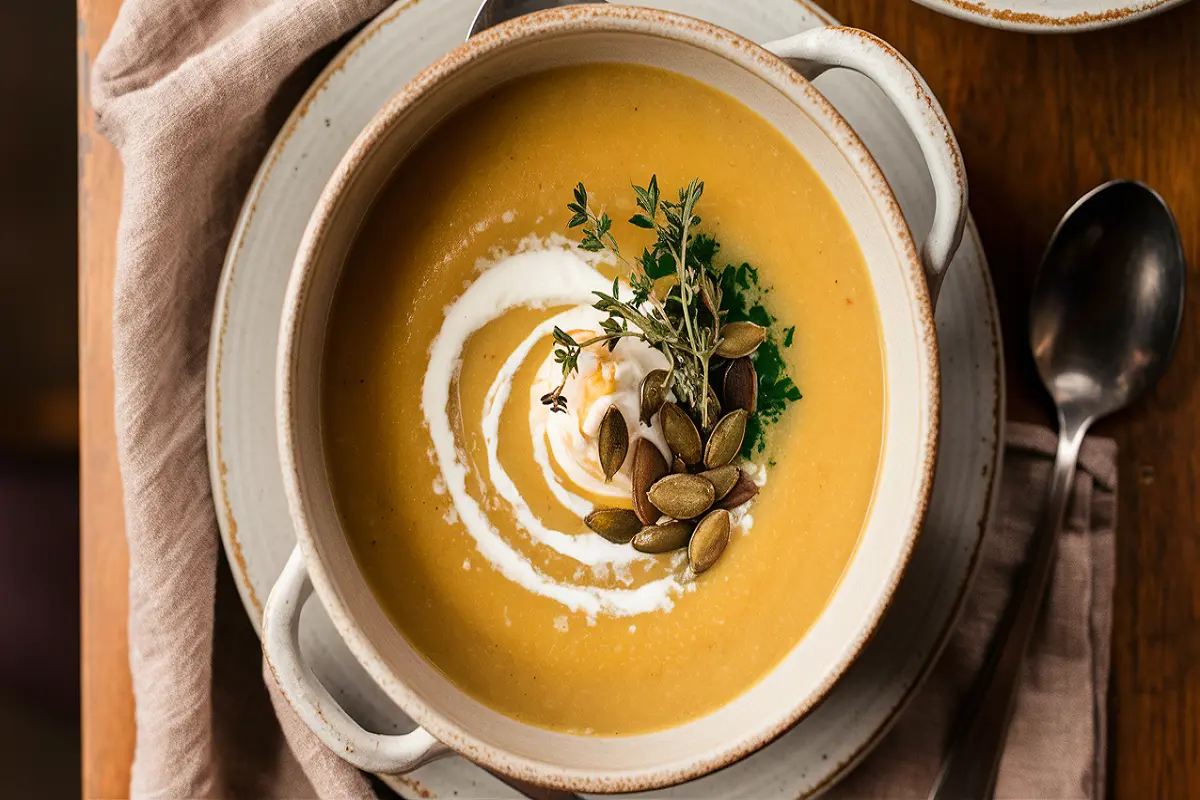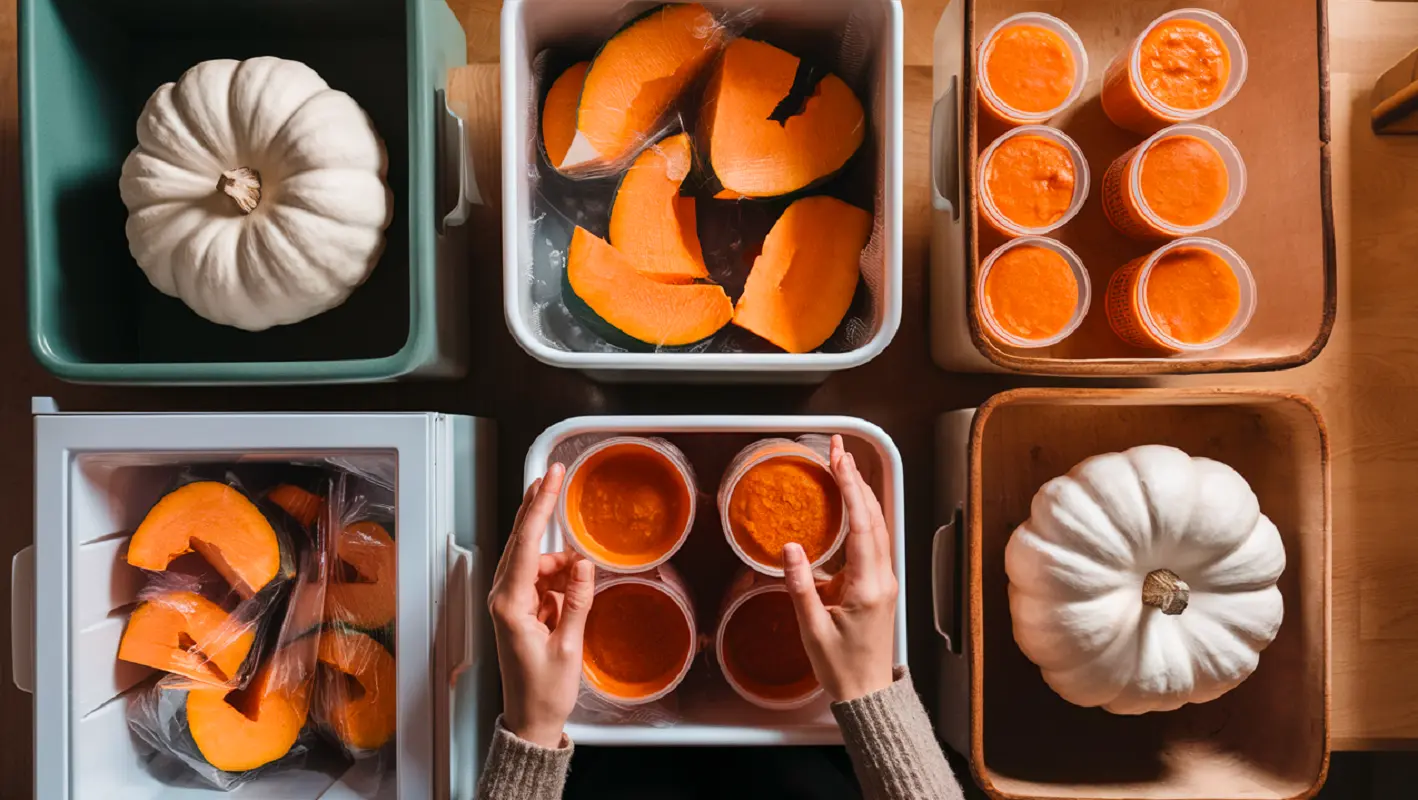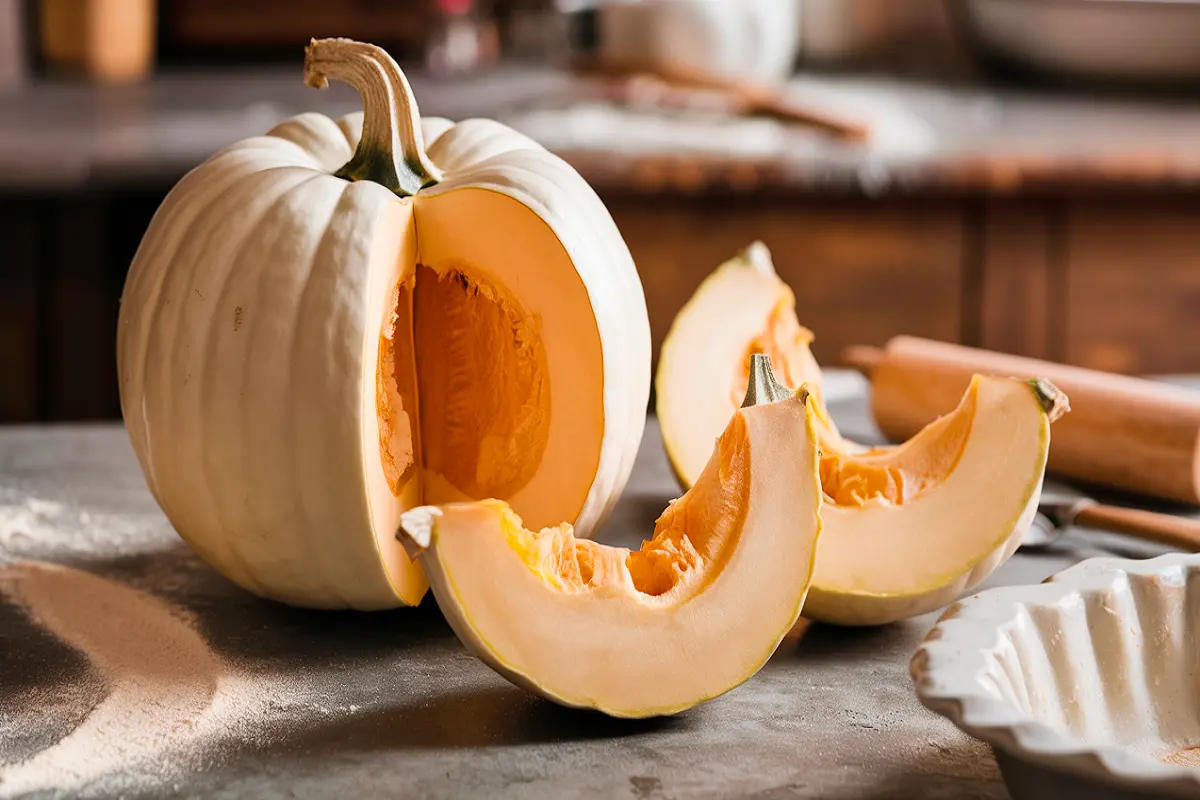Pumpkins are synonymous with fall, bringing to mind images of jack-o’-lanterns, cozy pies, and hearty soups. The bright orange pumpkin is most commonly associated with the season. However, another variety is often overlooked: the white pie pumpkin. This lesser-known relative of the traditional pumpkin offers a unique taste profile that’s worth exploring, especially for those who love experimenting in the kitchen.
The White Pie Pumpkin
White pie pumpkins, also known as “Lumina” or “ghost pumpkins,” are a unique variety that is pale or completely white on the outside. They have gained popularity not only for their striking appearance, which adds a modern touch to fall decor, but also for their culinary uses. Unlike traditional jack-o’-lantern pumpkins, bred more for their looks than taste, white pie pumpkins are cultivated specifically for their flavor and texture.
These pumpkins are typically smaller than their orange counterparts. They usually weigh between 4 to 8 pounds. The flesh inside is not white like the skin but rather a pale yellow or cream color. This flesh is the star of the show when it comes to cooking, offering a flavor slightly different from what you might expect from a standard pumpkin.
The Sensory Experience: What Does a White Pie Pumpkin Taste Like?
When it comes to taste, the white pie pumpkin delivers a subtle yet delightful experience. The flavor is generally milder and sweeter compared to the bold, earthy flavor of traditional orange pumpkins. This makes it an excellent choice for desserts. It’s also great for dishes where a lighter pumpkin flavor is desired.
1. Flavor Profile:
Mild Sweetness: White pie pumpkins have a natural sweetness that is less intense than that of sweet potatoes or butternut squash. This sweetness is delicate, allowing it to pair well with a variety of spices and other ingredients without overpowering them.
Nutty Undertones: Alongside the sweetness, you may notice a slight nuttiness in the flavor. This nutty aspect adds depth to the taste, making it more complex and interesting.
Creamy Texture: The flesh of the white pie pumpkin is slightly creamier than that of an orange pumpkin. This creaminess enhances the overall mouthfeel of dishes made with this pumpkin, making it ideal for silky pies and smooth purees.
2. Aroma:
- Subtle and Pleasant: The aroma of a white pie pumpkin is subtle, with faint hints of sweetness and a slight earthiness. When cooked, the aroma becomes more pronounced, filling the kitchen with a warm, inviting scent that is perfect for autumn.
3. Appearance in Dishes:
- Versatility: The pale flesh of the white pie pumpkin maintains its light color even after cooking, which can add an elegant touch to dishes. This makes it particularly appealing in dishes where presentation is key, such as in soups or as a puree atop a dish.
Culinary Uses: How to Incorporate White Pie Pumpkins into Your Cooking
White pie pumpkins are incredibly versatile in the kitchen. They can be used in much the same way as traditional pumpkins but bring a unique flavor and aesthetic to your dishes. Here are some ideas on how to use white pie pumpkins in your cooking:
1. Pumpkin Pie:
- A Classic with a Twist: The mild sweetness and creamy texture of the white pie pumpkin make it perfect for pumpkin pie. The flavor is subtle enough to let spices like cinnamon, nutmeg, and cloves shine. The creaminess ensures a smooth, velvety filling. Pair the white pie pumpkin with a spiced graham cracker crust for an extra layer of flavor.
2. Soups:

- Creamy and Comforting: White pie pumpkin can be used to make a rich and creamy pumpkin soup. Because the flavor is less intense, it blends beautifully with other ingredients like coconut milk, ginger, and lemongrass. The result is a comforting, velvety soup with a hint of sweetness and a creamy texture.
3. Purees and Sides:
- Smooth and Versatile: White pie pumpkin puree can be used as a base for a variety of side dishes. It pairs well with savory ingredients like garlic, sage, and browned butter. This puree can be served as a side dish on its own or as a component in more complex dishes like risotto or gnocchi.
4. Baked Goods:
- Adding Moisture and Flavor: Incorporating white pie pumpkin into baked goods like muffins, bread, or cakes adds a subtle pumpkin flavor and moisture, making the end product tender and rich. Try using white pie pumpkin puree in a spice cake or pumpkin bread for a seasonal treat.
5. Roasted Pumpkin:
- Simple and Delicious: One of the easiest ways to enjoy white pie pumpkin is by roasting it. The roasting process brings out the natural sweetness. It also enhances the nutty undertones. Simply cut the pumpkin into wedges, toss with olive oil, salt, and your favorite herbs, and roast until tender. Roasted white pie pumpkin makes a great side dish or a hearty addition to salads.
6. Pumpkin Butter:
- A Spread for All Seasons: White pie pumpkin can be turned into a delicious pumpkin butter, which can be spread on toast, stirred into yogurt, or used as a filling for pastries. The mild flavor of the white pie pumpkin allows the spices and sweeteners in the pumpkin butter to take center stage, resulting in a spread that is flavorful yet not overpowering.
Nutritional Benefits of White Pie Pumpkins
White pie pumpkins are not just delicious; they are also packed with nutrients that can contribute to a healthy diet. Here’s a closer look at the nutritional profile of this unique pumpkin:
1. Rich in Vitamins:
Vitamin A: Like all pumpkins, white pie pumpkins are an excellent source of vitamin A, which is essential for maintaining healthy vision, immune function, and skin health. Vitamin A in pumpkins comes in the form of beta-carotene, a powerful antioxidant.
For more information on the benefits of Vitamin A and how it supports overall health, you can visit this detailed article on Vitamin A
Vitamin C: White pie pumpkins also contain vitamin C, which supports the immune system, aids in the absorption of iron, and promotes healthy skin and connective tissue.
To learn more about the benefits of Vitamin C and its role in supporting your immune system, check out this comprehensive guide on Vitamin C
B Vitamins: This pumpkin variety provides a range of B vitamins, including folate, which is important for DNA synthesis and repair, and riboflavin, which helps convert food into energy.
To learn more about the benefits of Vitamin C and its role in supporting your immune system, check out this comprehensive guide on B Vitamins.
2. High in Fiber:
- Digestive Health: The flesh of white pie pumpkins is rich in dietary fiber, which aids in digestion, helps maintain a healthy weight, and reduces the risk of chronic diseases like heart disease and type 2 diabetes. The fiber content helps regulate blood sugar levels. This makes it a good choice for people managing diabetes.
3. Low in Calories:
- Weight Management: With its low-calorie content, white pie pumpkin is a great option for those looking to manage their weight without sacrificing flavor. It can be used in a variety of dishes to add bulk and nutrients without adding excessive calories.
4. Antioxidants:
- Cell Protection: White pie pumpkins are rich in antioxidants, which protect cells from damage caused by free radicals. This can help reduce inflammation in the body and lower the risk of chronic diseases such as heart disease and cancer.
5. Hydration:
- Water Content: White pie pumpkins have a high water content, which helps keep the body hydrated and supports overall health. The high water content also contributes to the pumpkin’s creamy texture when cooked.
Growing and Selecting White Pie Pumpkins
If you’re interested in growing your own white pie pumpkins or selecting the best ones at the market, here are some tips to keep in mind:
1. Growing Your Own:
- Planting: White pie pumpkins thrive in well-drained soil with plenty of sunlight. They should be planted after the last frost, as they need warm soil to germinate. Space the plants well to give them room to spread. Water them regularly, especially during dry spells.
- Harvesting: White pie pumpkins are ready to harvest when they have reached their full size and the skin is hard. The skin should be completely white without any green patches. Harvest them before the first frost. This will help you avoid damage to the pumpkins.
- Storing: Once harvested, white pie pumpkins can be stored in a cool, dry place for several months. Proper storage ensures that they retain their flavor and texture until you’re ready to use them.
2. Selecting at the Market:
- Appearance: When choosing a white pie pumpkin at the market, look for one that is uniformly white with no blemishes or soft spots. The skin should be firm to the touch, indicating that the pumpkin is fresh.
- Weight: A good quality white pie pumpkin should feel heavy for its size. This indicates that it is full of moisture and will have a better texture when cooked.
- Sound: Tap the pumpkin gently. It should produce a hollow sound, which indicates that it is ripe and ready to use.
Storing and Preserving White Pie Pumpkins

Proper storage and preservation are key to making the most of your white pie pumpkins. Here are some tips for keeping them fresh and ready to use:
1. Whole Pumpkin Storage:
- Cool and Dry: Store whole white pie pumpkins in a cool, dry place with good air circulation. A temperature range of 50-55°F (10-13°C) is ideal. Avoid storing them in a damp or humid environment, as this can lead to mold and spoilage.
2. Cut Pumpkin Storage:
- Refrigeration: Once a pumpkin has been cut, wrap the pieces tightly in plastic wrap or store them in an airtight container in the refrigerator. Use the cut pumpkin within a few days to ensure freshness.
3. Freezing Pumpkin Puree:
- Long-Term Storage: If you have more white pie pumpkin than you can use right away, consider making a puree and freezing it. To do this, cook the pumpkin until tender, puree it, and allow it to cool completely. Transfer the puree to airtight containers or freezer bags, leaving some space for expansion. Pumpkin puree can be frozen for up to six months.
4. Canning:
- Preservation: Canning is another method for preserving white pie pumpkin. Pumpkin puree should not be canned at home, as it is too dense to ensure safe canning. Instead, safely can cubed pumpkin in a pressure canner. Follow proper canning procedures to ensure safety and preserve the pumpkin’s flavor and texture.
White Pie Pumpkin: A Culinary Canvas
The white pie pumpkin’s subtle flavor and creamy texture make it a versatile ingredient in the kitchen. Whether you’re using it in traditional recipes or as a base for creative new dishes, it offers endless possibilities. Its mild taste allows it to pair well with a variety of flavors, from sweet to savory, making it a true culinary canvas.
1. Experiment with Spices:
- Enhancing Flavor: The delicate flavor of white pie pumpkin can be enhanced with a variety of spices. Cinnamon, nutmeg, and ginger are classic choices. Don’t be afraid to experiment with less traditional options like cardamom, star anise, or even a touch of cayenne pepper for some heat.
2. Pairing with Proteins:
- Complementary Combinations: White pie pumpkin pairs well with proteins such as pork, chicken, and even seafood. The mild sweetness of the pumpkin contrasts beautifully with the savory flavors of these proteins, creating a balanced and satisfying dish. For instance, roasted white pie pumpkin served alongside a pork tenderloin with a rosemary glaze creates a harmonious blend of flavors. Alternatively, try incorporating white pie pumpkin into a seafood chowder, where its creamy texture can enhance the richness of the dish.
3. Incorporating into Vegetarian Dishes:
- Versatile and Filling: The white pie pumpkin is a great ingredient for vegetarian dishes. Its natural sweetness and creamy texture can be used to create hearty, filling vegetarian meals. Consider using white pie pumpkin in a lasagna, layered with spinach, ricotta, and a sage-infused bechamel sauce. Another option is to stuff the pumpkin with a mixture of quinoa, cranberries, and nuts for a festive and nutritious main course.
4. Making Desserts:
- Subtle Sweetness: While pumpkin pie is a classic, the white pie pumpkin can be used in a variety of other desserts as well. Its subtle sweetness makes it a great ingredient in cakes, tarts, and even ice cream. Try making a white pie pumpkin cheesecake, where the creamy texture of the pumpkin pairs perfectly with a spiced crust and a tangy cream cheese topping. For a lighter dessert, white pie pumpkin can be used to create a delicate pumpkin mousse, flavored with a hint of vanilla and cinnamon.
Common Questions About White Pie Pumpkins
As more people discover the white pie pumpkin, naturally, some questions arise about this unique variety. Here are answers to some common inquiries:
1. How Does a White Pie Pumpkin Differ from an Orange Pumpkin?
- Flavor: The primary difference lies in the flavor. White pie pumpkins are milder and sweeter than their orange counterparts, making them ideal for dishes where a subtle pumpkin flavor is desired.
- Texture: White pie pumpkins tend to have a creamier texture, which can enhance the mouthfeel of dishes, especially desserts and purees.
- Appearance: Visually, the most obvious difference is the color. The white skin of the pie pumpkin offers a different aesthetic, both in raw form and when used in dishes.
2. Can You Eat the Skin of a White Pie Pumpkin?
- Edibility: The skin of a white pie pumpkin is technically edible, but it is often tough and not particularly pleasant to eat. For most dishes, remove the skin before cooking. However, if you roast the pumpkin, the skin can soften and be eaten along with the flesh.
3. How Do You Store a White Pie Pumpkin?
- Whole Pumpkins: Store whole pumpkins in a cool, dry place where they can last for several months. This makes them a great option for use throughout the fall and winter seasons.
- Cut Pumpkins: Once cut, white pie pumpkins should be stored in the refrigerator and used within a few days to maintain their freshness and flavor.
4. Are White Pie Pumpkins Good for Carving?
- Decorative Use: While white pie pumpkins can be carved, they are generally smaller and denser than traditional orange pumpkins, which can make them more challenging to carve. They are better suited for cooking or for use as a decorative element in their natural form.
Conclusion
The white pie pumpkin, with its delicate flavor, creamy texture, and elegant appearance, offers a refreshing twist on traditional pumpkin varieties. Whether you’re a seasoned cook looking for a new ingredient to experiment with or someone who enjoys the visual appeal of this unique pumpkin, there’s no denying that the white pie pumpkin has a lot to offer.
From savory soups to sweet desserts, this versatile pumpkin can be used in a wide range of dishes, bringing a subtle sweetness and a creamy texture that enhances the overall culinary experience. Its nutritional benefits make it a healthy addition to your diet, while its unique appearance adds a touch of elegance to any dish.
As more people discover the white pie pumpkin, it’s likely to become a staple in kitchens around the world, not just for its taste but also for its aesthetic appeal and versatility. So the next time you’re at the market, don’t overlook the humble white pie pumpkin – it might just become your new favorite ingredient.

